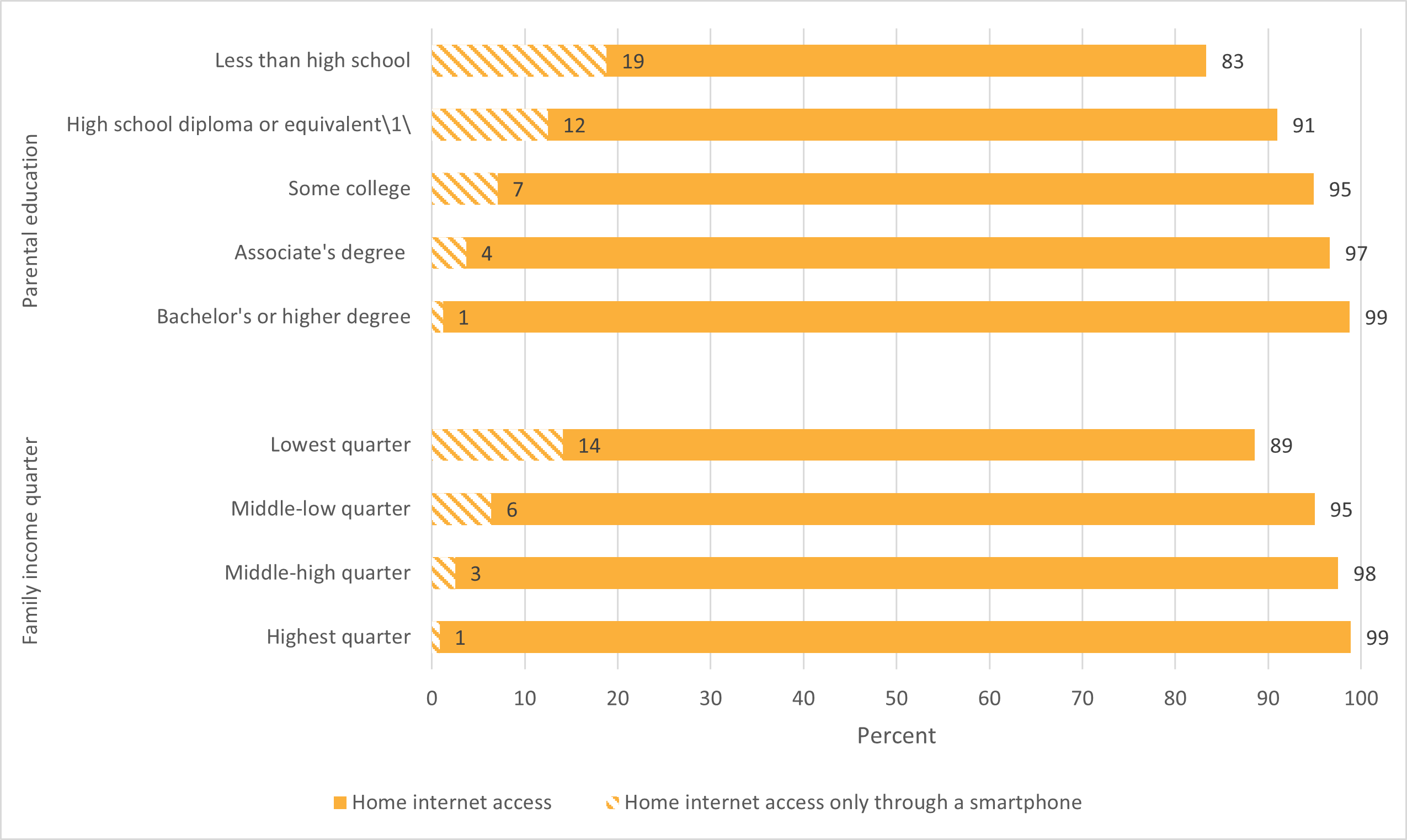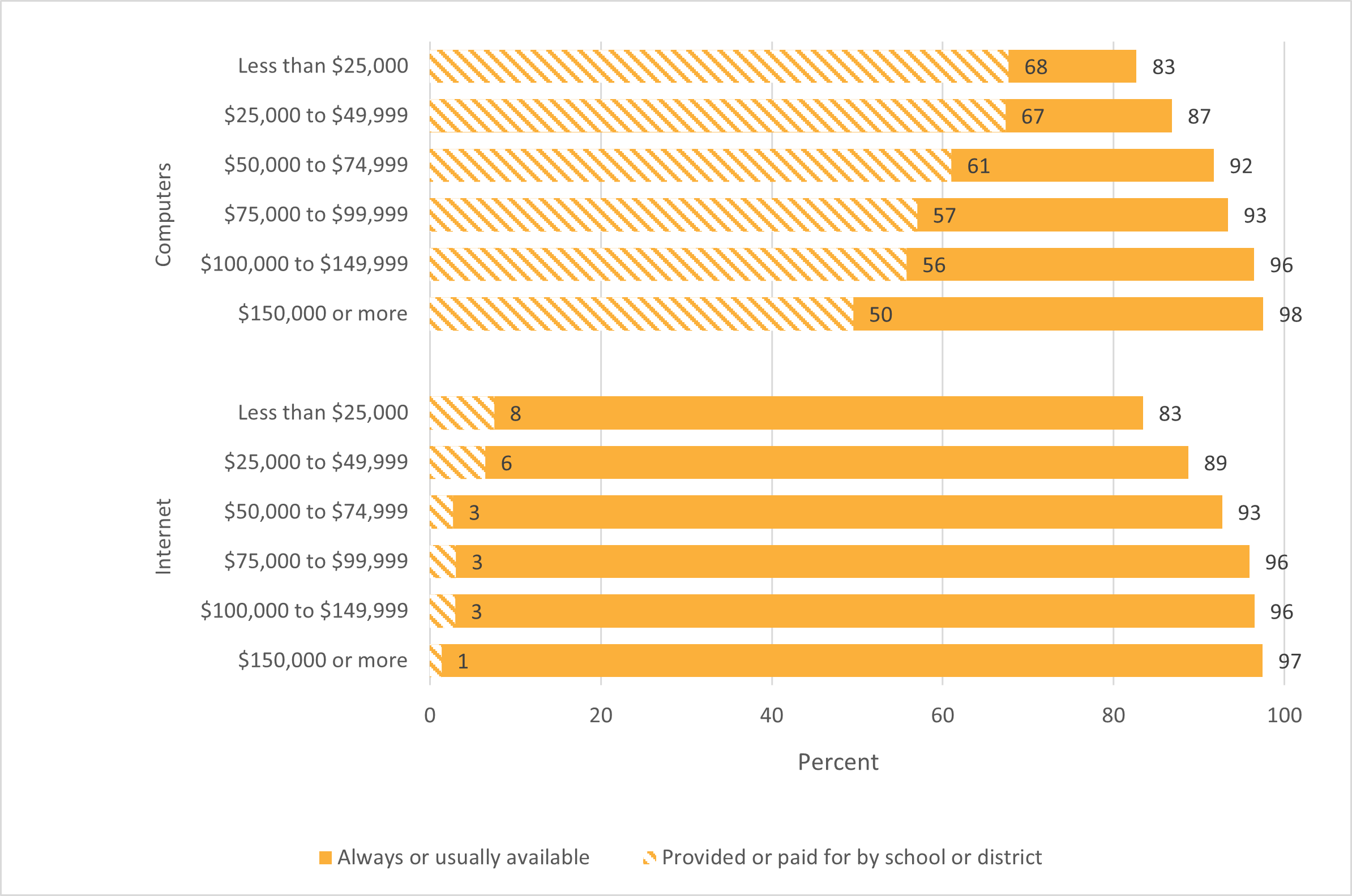The pandemic has focused attention on the resources needed for students to engage equitably in educational opportunities, particularly during remote learning. While access to computers and the internet were important to education prior to the pandemic—as tools for word processing, research, and communication after school hours, or even as the primary means of schooling—they became essential tools for students to remain engaged during the 2020–21 academic year. Reflecting this importance both before and during the pandemic, recent NCES blogs have highlighted data on virtual schools and geographic differences in digital access. This blog presents additional insight on these topics from the Condition of Education 2021. Specifically, it highlights patterns of inequity in access to educational technology by socioeconomic status, both before and during the coronavirus pandemic.
Before the Coronavirus Pandemic
According to the American Community Survey (ACS),1 the higher the level of parental educational attainment, the higher the percentage of 3- to 18-year-olds with home internet access in 2019. For instance, the percentage with home internet access was highest for those whose parents had attained a bachelor’s or higher degree (99 percent) and lowest for those whose parents had less than a high school credential (83 percent) (figure 1).
Similarly, the higher the level of family income, the higher the percentage of 3- to 18-year-olds with home internet access in 2019. Specifically, the percentage with home internet access was highest for those in families in the highest income quarter (99 percent) and lowest for those in families in the lowest income quarter (89 percent) (figure 1).2
Figure 1. Percentage of 3- to 18-year-olds with home internet access and home internet access only through a smartphone, by parental education and family income quarter: 2019

1 Includes those who completed high school through equivalency credentials, such as the GED.
NOTE: Includes only 3- to 18-year-olds living in households (respondents living in group quarters such as shelters, healthcare facilities, or correctional facilities were not asked about internet access). Includes 3- to 18-year-olds who had home internet access only through a smartphone but did not have any of the following types of computers: desktop or laptop, tablet or other portable wireless computer, or “some other type of computer.” Although rounded numbers are displayed, the figures are based on unrounded data.
SOURCE: U.S. Department of Commerce, Census Bureau, American Community Survey (ACS), 2019. See Digest of Education Statistics 2020, table 702.12.
While internet access is nearly universal in the United States (95 percent of all 3- to 18-year-olds had access in 2019), not all families access the internet the same way. Specifically, 88 percent had access through a computer,3 and 6 percent relied on a smartphone for their home internet access.4,5
In 2019, the higher the level of parental educational attainment, the lower the percentage of 3- to 18-year-olds who relied on a smartphone for their home internet access. Similarly, the higher the level of family income, the lower the percentage of 3- to 18-year-olds who relied on a smartphone for their home internet access. For instance, the percentage who relied on a smartphone for their home internet access was lowest for those in families in the highest income quarter (1 percent) and highest for those in families in the lowest income quarter (14 percent) (figure 1).
Taken together with the patterns for overall home internet access, these findings reveal that access only through a smartphone is generally more common for groups with lower rates of internet access overall. Importantly, although smartphones can be useful tools for staying connected, they offer more limited functionality for applications such as word processing or interactive learning platforms. In other words, overall levels of internet access mask further inequities in mode of access, which have implications for whether/how the internet can be used as an educational tool.
During the Coronavirus Pandemic
As students moved en masse to online learning during the pandemic, access to internet-connected devices became a requirement for students to participate effectively in their new learning environments. The pre-pandemic data described above suggest that not all students would have been in a position to take advantage of these remote classrooms, and that this would be true of a higher percentage of students whose parents had lower incomes or lower levels of educational attainment.
Some schools and districts helped students meet these needs by providing computers or paying for home internet access. Data from the Household Pulse Survey (HPS) show that 59 percent of adults6 with children in the home enrolled in school7 reported that computers were provided by their school or district. This percentage was generally higher for those with lower 2019 household incomes, ranging from 68 percent for adults with household incomes below $25,000 to 50 percent for adults with household incomes over $150,000 (figure 2). A similar pattern was observed for internet access. Overall, 4 percent of adults said internet access was paid for by their students’ district or school, ranging from 8 percent for adults in the lowest household income range to about 1 percent for those in the highest household income range. These patterns are consistent with higher rates of assistance going to families with higher rates of expected need (as indicated in figure 1).
Figure 2. Among adults 18 years old and over who had children under 18 in the home enrolled in school, percentage reporting that computers and internet access were always or usually available and provided or paid for by schools or school districts, by income level: September 2 to 14, 2020

NOTE: Although rounded numbers are displayed, the figures are based on unrounded data. Data in this figure are considered experimental and do not meet NCES standards for response rates. The survey question refers to enrollment at any time during the 2020–21 school year.
SOURCE: U.S. Department of Commerce, Bureau of the Census, Household Pulse Survey, collection period of September 2 to 14, 2020. See Digest of Education Statistics 2020, tables 218.85 and 218.90.
Even with this assistance from schools and districts, however, socioeconomic inequalities in students’ access to computers and internet were not eliminated. In general, the percentage of adults who reported that these resources were always or usually available increased with household income. For example, in September 2020, the percentage of adults reporting that computers were always or usually available was highest for the two household income levels at or above $100,000 and lowest for the two household income levels below $50,000. Similarly, the percentage of adults reporting that internet access was always or usually available was higher for the three household income levels at or above $75,000 than for the three household income levels below $75,000.
Both before and during the pandemic, these data show that overall access to education technology in the United States is high. This access is bolstered by widespread access to mobile devices like smartphones and—at least during the 2020–21 academic year—by resources provided by students’ schools and districts, particularly for students from lower socioecnomic backgrounds. Nevertheless, inequalities persist. As the prevalence of technology in education grows, it will be important to continue to track equity not only in access but also in quality of access and frequency and competency of use.
Explore the following resources to learn more about students’ access to, use of, and competency with education technology.
General
Access
- Condition of Education 2021
Use
Competency
By Véronique Irwin, NCES
[1] The American Community Survey (ACS) provides a large monthly sample of demographic, socioeconomic, and housing data comparable in content to the Long Forms of the Decennial Census. Aggregated over time, these data serve as a replacement for the Long Form of the Decennial Census. This section of the blog post uses data from ACS to describe the percentage of 3- to 18-year-olds with home internet access and the percentage with home internet access only through a smartphone in 2019.
[2] The highest quarter refers to the top 25 percent of all family incomes; the middle-high quarter refers to the 51st through the 75th percentile of all family incomes; the middle-low quarter refers to the 26th through the 50th percentile of all family incomes; and the lowest quarter refers to the bottom 25 percent of all family incomes.
[3] Refers to the percentage of 3- to 18-year-olds with home internet access through one or more of the following types of computers: desktop or laptop, tablet or other portable wireless computer, or “some other type of computer.” Includes homes having both smartphones and any of these types of computers.
[4] Refers to the percentage of 3- to 18-year-olds who had home internet access only through a smartphone but did not have any of the types of computers listed in endnote 3.
[5] Detail does not sum to totals because of rounding.
[6] The Household Pulse Survey, conducted by the Census Bureau and other agencies including NCES, gathers information from adults about household educational activities (as well as other topics). Because the data focus on adults, findings from HPS are not directly comparable to those from ACS mentioned above.
[7] According to HPS data, 52 million adults had children under age 18 in the home enrolled in school in September 2020. Overall, two-thirds (67 percent) of these adults reported that classes for their children had moved to a distance learning format using online resources.